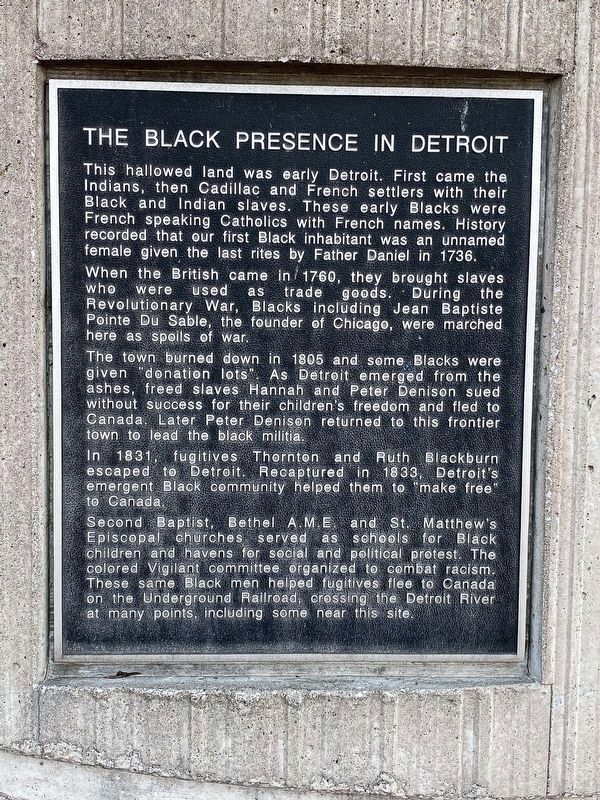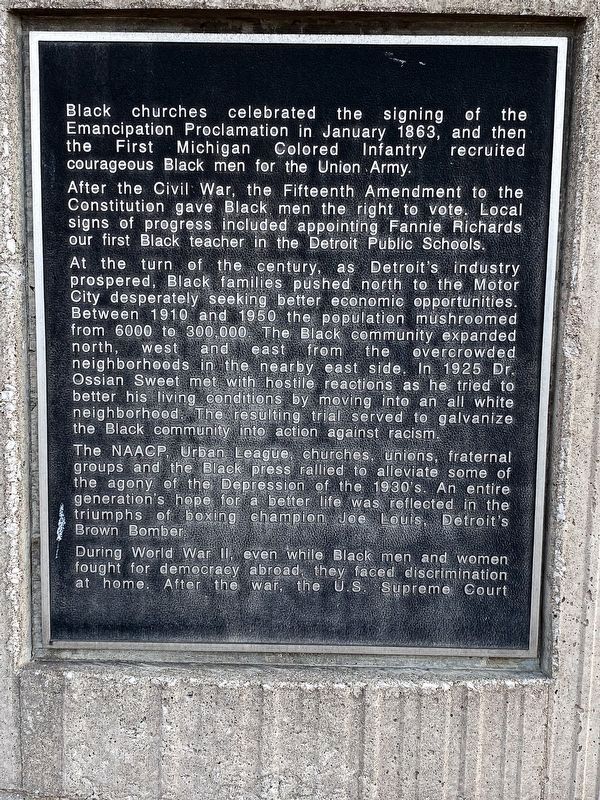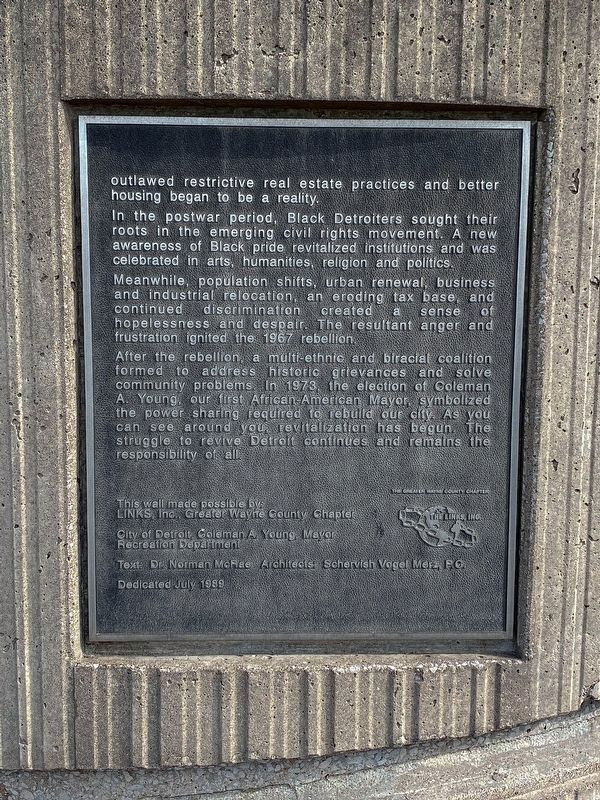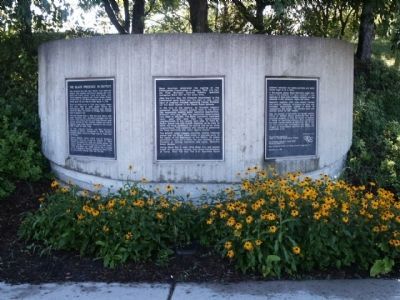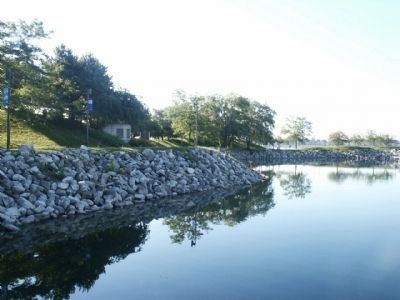Rivertown - Warehouse District in Detroit in Wayne County, Michigan — The American Midwest (Great Lakes)
The Black Presence in Detroit
When the British came in 1760, they brought slaves who were used as trade goods. During the Revolutionary War, Blacks including Jean Baptiste Pointe Du Sable, the founder of Chicago, were marched here as spoils of war.
The town burned down in 1805 and some Blacks were given "donation lots". As Detroit emerged from the ashes, freed slaves Hannah and Peter Denison sued without success for their children's freedom and fled to Canada. Later Peter Denison returned to this frontier town to lead the black militia.
In 1831, fugitives Thornton and Ruth Blackburn escaped to Detroit. Recaptured in 1833, Detroit's emergent Black community helped them to "make free" to Canada.
Second Baptist, Bethel A.M.E. and St. Matthew's Episcopal churches served as schools for Black children and havens for social and political protest. The colored Vigilant committee organized to combat racism. These same Black men helped fugitives flee to Canada on the Underground Railroad, crossing the Detroit River at many points, including near this site.
Panel 2
Black churches celebrated the signing of the Emancipation Proclamation in January 1863, and then the First Michigan Colored Infantry recruited courageous Black men for the Union Army.
After the Civil War, the Fifteenth Amendment to the Constitution gave Black men the right to vote. Local signs of progress included appointing Fannie Richards our first Black teacher in the Detroit Public Schools.
At the turn of the century, as Detroit's industry prospered, Black families pushed north to the Motor City desperately seeking better economic opportunities. Between 1920 and 1950 the population mushroomed from 6000 to 300,000. The Black community expanded north, west and east from the overcrowded neighborhoods in the nearby east side. In 1925 Dr. Ossian Sweet met with hostile reactions as he tried to better his living conditions by moving into an all white neighborhood. The resulting trial served to galvanize the Black community into action against racism.
The NAACP, Urban League, churches, unions, fraternal groups and Black press rallied to alleviate some of the agony of the Depression of the 1930's. An entire generation's hope for a better life was reflected in the triumphs of boxing champion Joe Louis, Detroit's Brown Bomber.
During World War II, even while Black men and women fought for democracy abroad, they faced discrimination at home. After the war, the U.S. Supreme Court
Panel 3
outlawed restrictive real estate practices and better housing began to be a reality.
In the postwar period, Black Detroiters sought their roots in the emerging civil rights movement. A new awareness of Black pride revitalized institutions and was celebrated in arts, humanities, religion and politics.
Meanwhile, population shifts, urban renewal, business and industrial relocation, an eroding tax base, and continued discrimination created a sense of hopelessness and despair. The resultant anger and frustration ignited the 1967 rebellion.
After the rebellion, a multi-ethnic and biracial coalition formed to address historic grievances and solve community problems. In 1973, the election of Coleman A. Young, our first African-American Mayor, symbolized the power sharing required to rebuild our city. As you can see around you, revitalization has begun. The struggle to revive Detroit continues and remains the responsibility of all.
Erected 1989 by The Links, Inc., Greater Wayne County Chapter.
Topics and series. This historical marker is listed in these topic lists: Abolition & Underground RR • African Americans • Civil Rights. In addition, it is included in the African Methodist Episcopal (AME) Church series list. A significant historical month for this entry is January 1863.
Location. 42° 20.017′ N, 83° 1.437′ W. Marker is in Detroit, Michigan, in Wayne County. It is in the Rivertown - Warehouse District. Marker can be reached from Atwater Street south of St. Aubin Street. This marker is in the William G. Milliken State Park and Harbor along the sidewalk east of the harbor. Touch for map. Marker is at or near this postal address: 1900 Atwater Street, Detroit MI 48207, United States of America. Touch for directions.
Other nearby markers. At least 8 other markers are within walking distance of this marker. Chapman Abraham / Jewish Soldiers in the Civil War (a few steps from this marker); Glimpses of Detroit's Riverfront History (about 300 feet away, measured in a direct line); Peter Wetherill Stroh (approx. 0.4 miles away); St. John's Presbyterian Church (approx. half a mile away); Black Bottom (approx. half a mile away); Fannie Richards Homesite (approx. 0.6 miles away); WGPR-TV (approx. 0.6 miles away); Holy Family Church (approx. 0.7 miles away). Touch for a list and map of all markers in Detroit.
Credits. This page was last revised on April 7, 2023. It was originally submitted on July 23, 2010, by Joel Seewald of Madison Heights, Michigan. This page has been viewed 2,131 times since then and 47 times this year. Photos: 1, 2, 3. submitted on March 1, 2023, by J.T. Lambrou of New Boston, Michigan. 4, 5. submitted on July 23, 2010, by Joel Seewald of Madison Heights, Michigan. • Bill Pfingsten was the editor who published this page.
